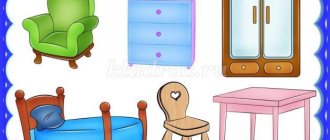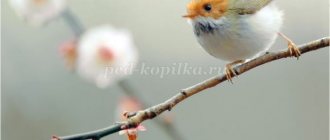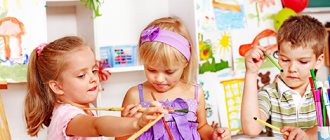In kindergarten, the teacher has the opportunity to use a wide variety of ways to teach coherent speech, but the main one is storytelling.
Typically, the following types of storytelling are distinguished:
- examination and description of toys and objects;
- storytelling based on the picture using leading questions;
- independently compiling stories from pictures;
- inventing continuations of stories or telling about what preceded them;
- talking about something from personal experience.
Teaching children creative storytelling begins with the preparatory work described above, which contributes to the acquisition of speech skills and helps them independently choose the development of the plot. Children learn to build subject-logical connections, a certain composition, and select the right words.
Creative storytelling
Creative storytelling is usually understood as storytelling based on proposed plots. In creative stories, children are asked to describe fictitious situations that did not actually happen. Children independently come up with fairy tales or stories, choosing the necessary images and situations within the framework of the topic given by the teacher.
The method of teaching preschoolers creative storytelling includes composing a creative story, when starting which children can be guided by:
- On real objects or pictures (What will happen next in the picture? What story can happen with toy animals?).
- For verbal instructions (write a story about how a puppy helped a kitten).
It is advisable to invite children to divide the story into two parts: first, talk about what actually exists, and then fantasize or remember something.
Children in the middle group are taught to correctly retell stories and fairy tales they have heard, and accurately describe objects and natural objects.
Children in the older group learn to compare objects with each other, tell stories from memory, compose stories from pictures, showing their imagination.
Summary of the lesson on speech development in the preparatory group “Telling from the imagination”
Introduction.
Teaching a child to tell means forming his coherent speech. This task is part of the general task of speech development in preschool age. Teaching a child to tell stories, i.e. independent coherent and consistent presentation of his thoughts, we help him find the exact words and phrases, construct sentences correctly, logically connect them with each other, observe the norms of sound and word pronunciation. In other words, we improve all aspects of the child’s speech - lexical, grammatical, phonemic.
In the pre-school group, a new type of learning for children is creative storytelling classes based on a proposed plot. Storytelling based on the plot enhances interest in storytelling in general and prepares them for literary and verbal creativity, which they will encounter at school.
Topic: 1. Inventing a fairy tale based on the proposed plot “The Adventures of the Hare”
2. Words - definitions and words denoting actions
Program content:
1) Continue to teach children to distinguish between literary genres.
2) Teach children to invent a fairy tale based on the proposed plot. Learn on your own, come up with a plot, the course of an event, a denouement, describe the place and time of action, observing the logic of plot development, actively using the accumulated knowledge of the presentation. Activate the imagination; activate adjective verbs in speech. Deepen interest in speech activity.
Progress of the lesson : - Guys, you have already learned to distinguish between different literary sentences, you already know what a story, a poem is, what a fairy tale is or why a work is called a fable, etc. “I’ll now read you an excerpt from a work familiar to everyone.” Listen to him carefully (I’m reading). -What did I read to you? Is it a fairy tale or a story, a poem or something else? (I’m reading an excerpt from V. Oseeva’s work “The Magic Word”) (children’s answers) - I include part of the work in the recording (an excerpt from a fairy tale). - What did you hear - a story or a fairy tale, or a poem? Why do you think so? What is a fairy tale? — I’m reading an excerpt from Chukovsky’s work “Confusion”
- What did you hear now - a poem, a fairy tale or a fable? What are fables? - Now guess who this riddle is about:
What kind of forest animal stood up,
like a post under a pine tree, And stands among the grass, Ears larger than head!
- That's right, this riddle is about a hare.
- Think and say what words can answer the question:
What hare? (smart, white, gray, long-eared, oblique, fluffy, cowardly, fleet-footed, careful, smart, etc.) - And when he runs away from the wolf. how can you say about him? What is he doing? (Rushes, rushes) - Today you will come up with a fairy tale about a hare. - Let's remember and say what a fairy tale is? — The fairy tale that you will come up with is called “The Adventures of the Hare.” Think about what your hare's name will be. Where and with whom the hare could live, what could happen to him, what time of year it was, what the hare could do, where he could go, and how his adventure ended. Do not forget to use in your fairy tales those interesting words about the hare that you have already named. Your fairy tales should be different, different beginnings and endings. A fairy tale must be told expressively, loudly, so that you can hear the heroes of your fairy tale talking - then the fairy tale will be interesting to listen to.
(2-3 minutes to think about it).
Children's stories (5-6 people). After each story, give an assessment, involve children in the assessment: “What did you like, what did you remember in the fairy tale? How does Yura tell the tale?
Essays-stories from the imagination. Teaching Techniques
To teach children creative storytelling, you need to clearly explain to them what the word “make up” means. The following tools will help:
- comparison of fictitious and real stories of children on the same topic;
- introducing an invented detail or situation into a story from personal experience.
Creative storytelling in kindergarten includes methods that help develop imagination:
- Before completing the task, the teacher offers different options for the events of one story, then the children, based on the proposed situations, come up with their own.
- Children complete the story that the teacher begins to tell; at the same time, the proposed situation should be “open” to various endings.
- The characters in the story are given a voice - direct speech is included.
- The story is told in relation to the author's face - a boy or a girl.
By developing a child’s speech, adults thereby develop his thinking.
So that children can understand the meaning of the story that they need to tell, the teacher helps them navigate the system of relationships that have developed in it:
- location (where does it take place?);
- time (when?);
- characters' goals (why are they doing anything?);
- order of events (what comes next?);
- analysis of causes and consequences (why does one thing lead to another?).
When the content becomes clear, the teacher invites the children to come up with a story according to a given pattern or plan.
A sample story is understood as a generalized description of an object or event that is accessible to children. Sometimes a “partial” sample is enough: when the beginning and end of the story are suggested. This technique is used to reinforce storytelling skills, as well as to show possible creative options.
The plan usually consists of two or three leading questions that determine the content of the story and the sequence of events. A plan helps solve a creative problem by providing food for imagination and thinking.
Creative storytelling in the preparatory group can also rely on modeling. A diagram is used as a model, which reflects the structure of the selected object and notes its most important qualities.
Most often, a circle consisting of three parts is used as a model: the beginning of the story, the main part and the conclusion. The model can be used to demonstrate the structure of the text proposed for the story, and subsequently as a visual aid when composing your own story.
MAGAZINE Preschooler.RF
Summary of GCD in the preparatory group. Creative storytelling, inventing a fairy tale.OO Communication.
Developer: Svetlana Nikolaevna Ustinova, teacher at the Children's Preschool Educational Institution "CRR-kindergarten "Druzhba" ", the city of Kachkanar, Sverdlovsk region.
Tasks:
Educational:
- Learn to invent and retell a fairy tale consistently, emotionally, logically, using models.
Create conditions for:
- improving the ability to correctly construct complex sentences, correctly ask questions, and come up with fairy tales of different content
- manifestations of communication skills, a sense of self-confidence. Expand children's active and passive vocabulary.
Educational:
Create conditions for:
- development of abilities, interests and motivation of activities (through the brownie Kuzya)
- development of creative imagination, initiative in composing fairy tales.
Educational: Instill in children a culture of behavior during class (listen to other children carefully, without interrupting, respect the statements of others). Create conditions for nurturing the ability to be surprised, rejoice, and admire the invented fairy tales of comrades.
Progress of the lesson.
- Guys, today I came to kindergarten not alone, but with my brownie Kuzya. He lives in my apartment and every evening before bed he tells me fairy tales. Would you like to meet him? (Yes)
- Kuzya, where are you?
- I'm here, I'm coming, I'm coming. Hello, kids, mischievous and naughty girls!
- Kuzenka, our children are obedient and inquisitive, nice and diligent, the smartest and kindest.
“I love people like that, so I brought with me a chest in which fairy tales live.” Children, do you like fairy tales? Wonderful! I’ll tell you riddles now, if you guess them, you’ll find out what fairy tales live in my chest. (He makes a wish, opens the chest, begins to cry.)
- What happened, Kuzya?
“I don’t have a single fairy tale left in my chest.”
- Don’t be sad, we will help your grief, the children will come up with many new fairy tales for you. (Kuzya is seated).
- Guys, let's remember what parts a fairy tale consists of? (Begin, middle, ending).
- What words does it begin with? (Once upon a time; in a certain kingdom, in a certain state...)
- What words does it end with? (I was there, I drank honey and beer, it flowed down my lips, but it didn’t get into my mouth; the fairy tale is a lie, but there is a hint in it, a lesson for a good fellow...)
— There are positive and negative heroes in a fairy tale. Name the positive ones - (Cinderella, Malvina...), the negative ones - (Baba Yaga, the snake Gorynovich...)
- Who do you like more, the one who does bad or the one who does good?
— Children, will the fairy tale work if there are only positive heroes or only negative ones? (No, because good always triumphs over evil.)
- That’s right, a fairy tale won’t turn out to be interesting if there is no evil gray wolf, a good Fairy... Children, miracles always happen in fairy tales, what kind? (There is witchcraft, magical objects, miracles happen.)
- Well done! Now let’s rest a little (physical education):
“Pinocchio stretched, once bent over, twice bent over. He spread his arms to the sides - apparently he couldn’t find the key,
To get that key, you have to stand on your toes.”
- Guys, today we will be storytellers. And these models will help you come up with a fairy tale.
Let's remember what this model means (I show, children tell).
- Children, you need to choose the characters of the fairy tale yourself and, based on the supporting pictures, come up with a fairy tale with a happy ending. Fairy tales should be different, not similar to each other. Whoever comes up with a more interesting idea will appreciate Kuzya. So, who is the bravest, who is ready to tell us a fairy tale? (Children talk).
- Kuzenka, whose fairy tale did you like best?
- Thank you, children, for the fairy tales. You all tried, that’s why the fairy tales turned out interesting. I will put your fairy tales in a chest and tell them to other children.
| Next > |
Themes of creative stories
Teaching children creative storytelling must be combined with introductory conversations about the rules of behavior. When choosing a topic for stories based on imagination, you need to focus on the main goals and objectives of education, focusing on the ethical actions of fictional characters. At the same time, we should not forget about the accessibility and attractiveness of the chosen topic.
You can also compose poems and fables with your children; come up with riddles and counting rhymes. Children really like them.
The results of children's creativity can be compiled into books and then re-read. You can also include children’s drawings in the books, illustrating their original texts. In general, this opens up a large field for creativity of the teacher himself.
Compiling a fairy tale (preparatory group)
Educator: Guys, have we finished composing the fairy tale? What else do we need to do?
Children answer questions (come up with the end of a fairy tale, find out how it all ends)
Educator: And now we will try to come up with the end of the fairy tale, relying on hints - diagrams. I'll post clues and you can guess what they mean. And only then will we open the last page.
The teacher posts picture tips.
- What do you think the first clue means? Is it possible to take home a stray animal and pet it on the street without adults? Where did the owners take the kitten first? Has Murka become friends with the kitten? Does he like living in a house with his owners? How did you understand this?
Children answer questions.
Educator: Let's look at the picture.
Were we right? Can you say that the kitten is sad or feels bad?
Children: No.
Educator: Who wants to tell the end of the fairy tale?
The child tells the end of the fairy tale.
Educator: I think it would be interesting to listen to the whole fairy tale. Who wants? I am sure that you will succeed, and if you find it difficult, then the hint pictures and the guys will help you.
The child tells the story in full.
Educator: The kitten loves to play. And you?
Warm up.
The teacher shows schematic cards; children must complete the exercises shown on the cards.
If you see a picture of a boy, then only boys perform it. If you see a picture of a girl, then only girls do it. Well, if there is a picture of a little man, then they do everything. The last picture is of the guys holding hands.
Educator: Well done, guys! You were very attentive, and I saw how hard you tried.
Standing in a circle:
— Guys, if you take a pet home, you need to be responsible for it. This is a domestic animal, which means it is very difficult for it to live without a person. Every day, homeless animals die on the street: some from cold and hunger; someone is under the wheels of a car. Look after, love, take care of your pet!
Reflection:
—
Did you like solving riddles - diagrams?
- What did we want to compose and come up with today?
— What helped us cope with the task?
—Who can you tell this tale to?
—Are you happy with yourself today?
I'm very pleased with you. Thank you very much for your work. I want you to have such a kitten. If you liked everything today and are still in a good mood, you will draw a cheerful face for the kitten. If you were bored, then you will draw a sad face for the kitten.
Expected result:
The children composed a fairy tale based on a set of pictures with a sequentially developing plot. A schematic model was used as a plan. They can explain the figurative expression “The eyes are the mirror of the soul.” Show respect and compassion for pets. They can tell a fairy tale to their loved ones.






